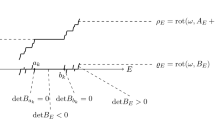Abstract
Consider the perturbed harmonic oscillator Ty=-y’’+x2y+q(x)y in L2(ℝ), where the real potential q belongs to the Hilbert space H={q’, xq∈ L2(ℝ)}. The spectrum of T is an increasing sequence of simple eigenvalues λ
n
(q)=1+2n+μ
n
, n ≥ 0, such that μ
n
→ 0 as n→∞. Let ψ
n
(x,q) be the corresponding eigenfunctions. Define the norming constants ν
n
(q)=lim
x
↑∞log |ψ
n
(x,q)/ψ
n
(-x,q)|. We show that  for some real Hilbert space
for some real Hilbert space  and some subspace
and some subspace  Furthermore, the mapping ψ:q↦ψ(q)=({λ
n
(q)}0∞, {ν
n
(q)}0∞) is a real analytic isomorphism between H and
Furthermore, the mapping ψ:q↦ψ(q)=({λ
n
(q)}0∞, {ν
n
(q)}0∞) is a real analytic isomorphism between H and  is the set of all strictly increasing sequences s={s
n
}0∞ such that
is the set of all strictly increasing sequences s={s
n
}0∞ such that  The proof is based on nonlinear functional analysis combined with sharp asymptotics of spectral data in the high energy limit for complex potentials. We use ideas from the analysis of the inverse problem for the operator -y”py, p∈ L2(0,1), with Dirichlet boundary conditions on the unit interval. There is no literature about the spaces
The proof is based on nonlinear functional analysis combined with sharp asymptotics of spectral data in the high energy limit for complex potentials. We use ideas from the analysis of the inverse problem for the operator -y”py, p∈ L2(0,1), with Dirichlet boundary conditions on the unit interval. There is no literature about the spaces  We obtain their basic properties, using their representation as spaces of analytic functions in the disk.
We obtain their basic properties, using their representation as spaces of analytic functions in the disk.
Similar content being viewed by others
References
Bateman, H.: Higher transcendental functions. Vol. II, New York-Toronto-London: McGraw-Hill, 1953
Chelkak, D., Kargaev, P., Korotyaev, E.: An Inverse Problem for an Harmonic Oscillator Perturbed by Potential: Uniqueness. Lett. Math. Phys. 64(1), 7–21 (2003)
Chelkak, D.S.: Approximation in the Space of Spectral Data of a Perturbed Harmonic Oscillator. J. Math. Sci. 117(3), 4260–4269 (2003)
Fedoryuk, M.: Asymptotic Analysis. Berlin-Heidelberg: Springer-Verlag, 1993
Gurarie, D.: Asymptotic inverse spectral problem for anharmonic oscillators. Commun. Math. Phys. 112(3), 491–502 (1987)
Gurarie, D.: Asymptotic inverse spectral problem for anharmonic oscillators with odd potentials. Inverse Problems 5(3), 293–306 (1989)
Gesztesy, F., Simon, B.: Uniqueness theorems in inverse spectral theory for one-dimensional Schrödinger operators. Trans. Am. Math. Soc. 348(1), 349–373 (1996)
Gesztesy, F., Simon, B.: The xi function. Acta Math. 176(1), 49–71 (1996)
Gesztesy, F., Simon, B.: On local Borg-Marchenko uniqueness results. Commun. Math. Phys. 211(2), 273–287 (2000)
Levitan, B.: Sturm-Liouville operators on the entire real axis with the same discrete spectrum. Math. USSR-Sb. 60(1), 77–106 (1988)
McKean, H.P., Trubowitz, E.: The spectral class of the quantum-mechanical harmonic oscillator. Commun. Math. Phys. 82(4), 471–495 (1981/82)
Olver, F.: Two inequalities for parabolic cylinder functions. Proc. Camb. Phil. Soc. 57, 811–822 (1961)
Pöschel, P., Trubowitz, E.: Inverse Spectral Theory. Boston: Academic Press, 1987
Reed, M., Simon, B.: Methods of Modern Mathematical Physics. Vol. II, Fourier Analysis, Self-Adjointness. New York: Academic Press, 1975
Zigmund, A.: Trigonometric series. London-New York: Cambridge Univ. Press, 1968
Author information
Authors and Affiliations
Corresponding author
Additional information
Communicated by B. Simon
Rights and permissions
About this article
Cite this article
Chelkak, D., Kargaev, P. & Korotyaev, E. Inverse Problem for Harmonic Oscillator Perturbed by Potential, Characterization. Commun. Math. Phys. 249, 133–196 (2004). https://doi.org/10.1007/s00220-004-1105-8
Received:
Accepted:
Published:
Issue Date:
DOI: https://doi.org/10.1007/s00220-004-1105-8



